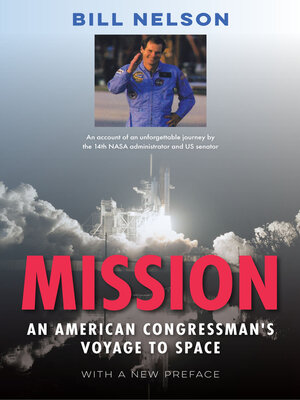
Sign up to save your library
With an OverDrive account, you can save your favorite libraries for at-a-glance information about availability. Find out more about OverDrive accounts.
Find this title in Libby, the library reading app by OverDrive.



Search for a digital library with this title
Title found at these libraries:
| Library Name | Distance |
|---|---|
| Loading... |
14th NASA administrator and US Senator Bill Nelson's account of an unforgettable Space Shuttle mission
In January 1986, US congressman and future NASA leader Bill Nelson flew on the six-day mission of the Space Shuttle Columbia. Nelson conducted medical experiments, including cancer research and the first American stress test in space. Mission is Nelson's account of this journey, originally published two years after the flight and now available in this paperback edition with a new preface.
In this book, Nelson recounts how he was selected as a payload specialist and details his training regimens with the crew for the flight and mission. He describes the experience of launch, living in zero gravity, and returning to Earth. Nelson also addresses the Space Shuttle Challenger disaster, which happened just 10 days after his own mission ended, discussing its impact on himself and the nation and the changes in NASA mission directives that followed. The book includes Nelson's early perspectives on the goals and principles of the US space program, the value of conducting research in weightless environments, and the necessity of collaborations in developing advanced space technologies.
Mission offers a fascinating window into the Space Shuttle program during the pre-Challenger era. Forty years later, NASA has seen the completion of the International Space Station, long-term partnerships with other national space agencies, and the expanding role of private space companies. Nelson's hopes and predictions in these areas are significant contributions to space history and markers that show how far the space program has come.
In January 1986, US congressman and future NASA leader Bill Nelson flew on the six-day mission of the Space Shuttle Columbia. Nelson conducted medical experiments, including cancer research and the first American stress test in space. Mission is Nelson's account of this journey, originally published two years after the flight and now available in this paperback edition with a new preface.
In this book, Nelson recounts how he was selected as a payload specialist and details his training regimens with the crew for the flight and mission. He describes the experience of launch, living in zero gravity, and returning to Earth. Nelson also addresses the Space Shuttle Challenger disaster, which happened just 10 days after his own mission ended, discussing its impact on himself and the nation and the changes in NASA mission directives that followed. The book includes Nelson's early perspectives on the goals and principles of the US space program, the value of conducting research in weightless environments, and the necessity of collaborations in developing advanced space technologies.
Mission offers a fascinating window into the Space Shuttle program during the pre-Challenger era. Forty years later, NASA has seen the completion of the International Space Station, long-term partnerships with other national space agencies, and the expanding role of private space companies. Nelson's hopes and predictions in these areas are significant contributions to space history and markers that show how far the space program has come.







